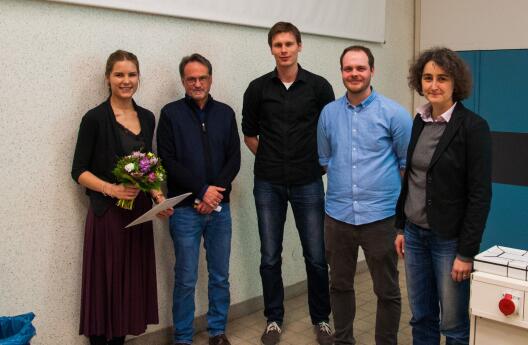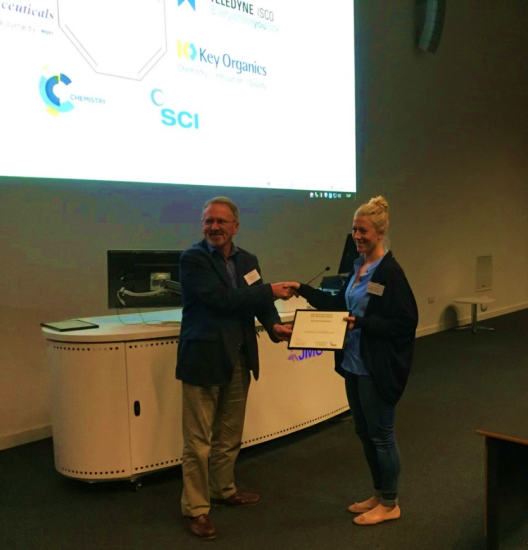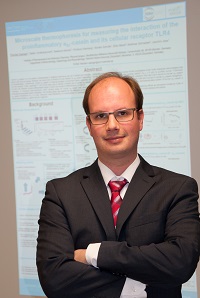Termine
Einführungsveranstaltungen / Vorbesprechungstermine der Praktika
Bitte beachten Sie immer die verbindlichen Aushänge und Vorlesungsankündigungen am Schwarzen Brett!
Aktuelles

DPhG-Dissertationspreis
Auf der diesjährigen Jahrestagung der Deutschen Pharmazeutischen Gesellschaft wurde Frau Dr. Kathrin Brömmel für ihre exzellente Dissertation mit dem Titel "Synthese und Evaluation von small molecule probes zur Bildgebung des KCA3.1-Kanals in vitro und in vivo" mit dem Walter-Schunack-Preis 2021 ausgezeichnet.

Posterpreis für Robin Birus
Robin Birus, Doktorand in der Arbeitsgruppe von Herrn Prof. Jose am Institut für Pharmazeutische und Medizinische Chemie, wurde im Rahmen der DPhG-Doktorandentagung, die vom 11. bis 12. März 2021 als virtuelles Meeting stattfand, mit dem Posterpreis ausgezeichnet. Dieser wurde ihm für sein Poster mit dem Titel „Anti-Cancer Drug Potential of CK2 Inhibitors with an Indeno[1,2-b]indole Scaffold: Analysis of Cellular Effects and Pharmacokinetic Properties“ verliehen.

GBM-Masterpreisverleihung 30.01.2019
Am 30.01.2019 wurde Sarah Hardebeck der GBM-Masterpreis der jGBM Münster für ihre herausragende Abschlussarbeit auf dem Gebiet der Biochemie und Molekularbiologie verliehen. Die Arbeit mit dem Titel „Entwicklung eines Verfahrens zur quantitativen Analyse der Interaktion von p15PAF und PCNA“ wurde von Sarah Hardebeck in der Arbeitsgruppe von Prof. Dr. Joachim Jose im Institut für Pharmazeutische und Medizinische Chemie der WWU angefertigt und mit einer einjährigen kostenfreien GBM-Mitgliedschaft prämiert.

Best Flash Presentation Award für Isabelle Lengers
Isabelle Lengers, Doktorandin in der Arbeitsgruppe von Prof. Jose am Institut für Pharmazeutische und Medizinische Chemie, PharmaCampus, wurde anlässlich der Tagung „GP2A 2017 - 25th Annual Medicinal Chemistry Conference“ in Liverpool am 1.9.2017 mit dem Best Flash Presentation Award ausgezeichnet, der mit 150 GBP dotiert ist.
Der Titel des Beitrags lautete:
„Human Hyal‑1 – from in silico pharmacophore modeling to in vitro inhibitor screening”
und beschäftigt sich mit der Entwicklung eines Pharmakophor Models zur Identifizierung potentieller Hyaluronidase-1 Inhibitoren.
Poster und Vortrag PF5:
Lengers I, Hermann F, Haidar S and Jose J
“Human Hyal‑1 – from in silico pharmacophore modeling to in vitro inhibitor screening”
Abstract
The endoglycosidase hydrolase Hyaluronidase 1 (Hyal‑1) is one of five hyaluronidases in human body. Degradation of high molecular weight hyaluronan (HA) is mainly catalyzed by Hyal-1 into smaller fragments. These fragments have inflammatory and angiogenic effects.1 The role of Hyal-1 in cancer progression, e. g prostate or bladder cancer, has been discussed for a long time. In several cancer types, the expression level of Hyal-1 was elevated in comparison to not malignant cells, resulting in higher Hyal‑1 activity and tumor progression.2,3 Although Hyal‑1 is an interesting target for pharmaceutical purposes, no potent inhibitors have been found so far. The enzyme source seems to be the bottleneck in investigation of potent inhibitors. Production of active Hyal‑1 is one of the most challenging tasks. Eukaryotic extraction and purification is very time consuming and expensive. Recombinant expression in bacteria leads to inactive Hyal-1 forming inclusion bodies. Therefore, potent Hyal-1 inhibitors, like chemical compounds or plant extracts, are routinely screened against bovine testis hyaluronidase, which has an amino acid sequence identity of approx. 40 % compared to human Hyal‑1. This again causes problems in interpretation of the obtained data, development of a pharmacophore model or searching for leader compounds inhibiting human Hyal‑1. Using Autodisplay technology, we are able to express human Hyal-1 on the surface of Escherichia coli in an active form.4 With this system, it is possible to screen compounds, directly using the desired target. A combination of pharmacophore modeling followed by docking studies using a virtual system, helped us to get first impressions about binding of the substances to Hyal-1. Next, screening the best hits with whole-cells displaying Hyal-1 seems to be a promising way to find the needle in the haystack.

Posterpreis für Thorsten Saenger
Thorsten Saenger, Doktorand in der Arbeitsgruppe von Prof. Jose am Institut für Pharmazeutische und Medizinische Chemie, PharmaCampus, wurde anlässlich der Tagung „Forschung der Chemischen Industrie“ am 4.5.2017 mit dem Posterpreis ausgezeichnet.
Der Titel des Beitrags lautete:
„Microscale thermophoresis for measuring the interaction of the proinflammatory alpha S1-casein and its cellular receptor TLR4 ”
und beschäftigt sich mit der Aufklärung der Interaktion des proinflammatorischen Muttermilchproteins αS1-Casein mit dem TLR4 Rezeptor des angeborenen Immunsystems.
Poster 35
Thorsten Saenger, Stefan Vordenbäumen, Swetlana Genich, Christian Nienberg, Marten Schulte, Ellen Bleck, Matthias Schneider, Joachim Jose
„Microscale thermophoresis for measuring the interaction of the proinflammatory alpha S1-casin and its cellular receptor TLR4”
Abstract
Human αS1-casein is a milk protein overexpressed in lactating mamma as well as in breast and prostate cancer and synovia tissues. Recently, we could show a lifelong immune reaction to αS1-casein depending on breastfeeding1. Furthermore, human αS1-casein is inducing secretion of proinflammatory cytokines via Toll-like receptor (TLR4) signaling2,3,4. Aim of this study was to identify a binding site of human αS1-casein to TLR4 with cofactors myeloid differentiation factor 2 (MD2) and cluster of differentiation 14 (CD14).
Therefore, a microscale thermophoresis (MST) binding assay for human αS1-casein was developed, considering postulated protein properties. This binding assay was specific for the detection of the human αS1-casein interactions (KD = 2.2 µM). Moreover, clear differences in multimerization of unphosphorylated and phosphorylated αS1-casein became apperent.
Using this microscale thermophoresis assay for the investigation of the TLR4 interaction demonstrated that human αS1-casein is a stronger in vitro binding partner (KD = 2.2 µM) to purified human TLR4/MD2 compared to LPS (KD = 8.2 µM). Additionally, both cofactors MD2 and CD14 bound to human αS1-casein (KD(MD2) = 0.3 µM and KD(CD14) = 2.7 µM). Therefore, both are involved in human αS1-casein recognition.
Furthermore, we could support former findings that the unphosphorylated isoform of human αS1-casein binds to the receptor exclusively.
These results emphasizes the role of human αS1-casein exerting effects as competitive binder to TLR4 in infancy nutrition as exogen protein and as endogen in autoimmune disease and cancer.


